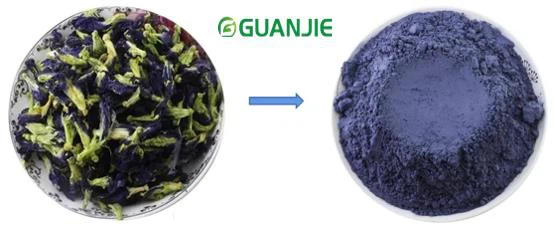Butterfly pea blossom powder is from the butterfly pea flower (scientifically known as Clitoria ternatea) is not just a beautiful ornamental plant native to Southeast Asia-it is also a marvel of natural chemistry. One of its most fascinating characteristics is its ability to change color when exposed to different pH levels. This magical transformation has made butterfly pea flower a popular ingredient in herbal teas, cocktails, and natural food dyes. But what exactly causes this flower to change color?

What is Butterfly Pea Flower?
Butterfly pea flower is a deep blue or purple flower belonging to the Fabaceae (legume) family. The plant is widely found in tropical regions of Asia, such as Thailand, Malaysia, and Indonesia. Traditionally, the flower has been used in Ayurveda and other herbal medicines for its cognitive-enhancing and anti-inflammatory properties.
In recent years, Butterfly pea blossom powder has gained popularity globally due to its vibrant color and visual appeal. The blue butterfly pea flower powder is used to make tea, which starts out as a vivid blue and can change to purple or pink when acidic ingredients like lemon juice are added. This property has intrigued scientists, chefs, and mixologists alike.
The Chemistry Behind the Color
Anthocyanins: The Key Pigments
The secret behind the butterfly pea flower's striking ability to change color lies in a group of natural pigments called anthocyanins. These are water-soluble compounds that belong to the larger flavonoid family and are commonly found in many plants. Anthocyanins are responsible for a range of colors-most notably the reds, purples, and blues-in flowers, fruits, and vegetables such as blueberries, grapes, and red cabbage.
In the case of the blue butterfly pea flour (Clitoria ternatea), the predominant anthocyanins are a specific subtype known as ternatins. These unique molecules give the flower its characteristic deep blue hue when in its natural, unprocessed state. Ternatins are distinguished by their chemical structure, which includes several acyl groups (organic acid chains) that make them especially stable.
How Structure Influences Color
To understand why these pigments change color, we must look at Butterfly pea blossom powder's molecular structure. All anthocyanins share a common chemical backbone known as the flavylium ion. This structure is highly sensitive to changes in pH-the measure of acidity or alkalinity in a solution. As the butterfly blue pea powder pH of the surrounding environment changes, the anthocyanin molecules undergo structural transformations, each with different light-absorbing properties. This causes their color to shift visibly.
In acidic environments (low pH), anthocyanins maintain their flavylium ion form, which absorbs light in a way that makes them appear red or pink.
At a neutral pH, the structure transitions into what's called a quinoidal base, giving rise to purple or violet hues.
In alkaline conditions (high pH), the molecules convert into other forms such as chalcones, resulting in greenish or yellowish colors.
This dynamic interaction between pH and structure is what allows butterfly pea flower tea, for example, to change from blue to purple or even pink when lemon juice is added.

Stability and Function of Ternatins
What sets Butterfly pea blossom powder apart from other sources of anthocyanins is the high stability of ternatins. These compounds have extra acyl groups attached to their molecular structure, a process known as acylation. This modification enhances the pigment's resistance to environmental stresses like heat, light, and pH fluctuations.
How pH Affects Color?
The color-changing property of butterfly pea flower is closely tied to pH levels. The pH scale, which ranges from 0 to 14, indicates how acidic or basic a solution is-where 0 is highly acidic, 7 is neutral, and 14 is strongly alkaline. The vivid hues seen in butterfly pea tea are due to anthocyanins, a group of natural pigments that are highly sensitive to pH changes.
At different pH levels, the molecular structure of anthocyanins transforms, which changes how they interact with light. These structural shifts affect the wavelengths of light that the molecules absorb and reflect, resulting in noticeable color changes. For example, in a neutral solution (around pH 7), Butterfly pea blossom powder appears a vibrant blue. When an acid like lemon juice is added, the pH drops and the color shifts to purple or pink. On the other hand, adding a basic substance such as baking soda raises the pH, turning the tea green or even yellow.
This color transformation is not only visually striking but also functional. It allows butterfly pea flower to act as a natural pH indicator, making it useful in both culinary arts and scientific demonstrations. Its ability to reflect pH variation through visible color shifts has made it a popular ingredient in teas, cocktails, and educational experiments.
|
pH Level |
Color |
|
< 3 (strong acid) |
Reddish-pink |
|
4–6 (weak acid) |
Purple |
|
7 (neutral) |
Blue |
|
8–9 (mildly basic) |
Greenish-blue |
|
> 10 (alkaline) |
Yellow to pale green |
Real-Life Examples
Adding lemon juice to Butterfly pea blossom powder turns it from blue to purple or magenta due to increased acidity.

Adding baking soda raises the pH and turns the tea greenish or even yellow.
This color-changing reaction is not only visually impressive but also useful as a natural pH indicator.
Scientific Studies and Analysis
Numerous scientific studies have been conducted to investigate the unique chemical and physical properties of the anthocyanins found in butterfly pea flowers, particularly focusing on the behavior of ternatins-the specialized pigments responsible for the flower's vivid blue color and its remarkable ability to change hues in response to pH changes.
UV-Visible spectrophotometry
One of the primary analytical techniques used in these investigations is UV-Visible spectrophotometry. This method allows researchers to study how light interacts with the anthocyanins in solution. When the pH of the Butterfly pea blossom powder environment changes, the molecular structure of the anthocyanins also shifts, which in turn alters the wavelengths of light they absorb. These changes are recorded as shifts in the absorption maxima on the spectrophotometric graph. For example, at a low pH (acidic environment), the pigment may absorb light differently than it does at a high pH (alkaline environment), leading to observable color shifts from blue to purple or green. These absorption characteristics are critical for understanding the dynamic visual transformations that butterfly pea flower extract undergoes.
HPLC and LC-MS
In addition to spectrophotometric analysis, scientists have utilized High-Performance Liquid Chromatography (HPLC) and Liquid Chromatography–Mass Spectrometry (LC-MS) to delve deeper into the molecular composition of butterfly pea flower pigments. HPLC enables precise separation of the different ternatin compounds present in the Butterfly pea blossom powder, while LC-MS further helps in identifying the exact molecular weights and structures of these compounds. This detailed chemical profiling has confirmed that butterfly pea flower contains a range of polyacylated anthocyanins, predominantly ternatins, which are responsible for the extract's intense coloration and its relative stability compared to other natural dyes.
Stability studies
Stability studies have also been a major focus of scientific research, as they assess how Butterfly pea blossom powder anthocyanins respond to various environmental factors such as heat, light, and pH. These studies have demonstrated that ternatins exhibit a higher level of stability under heat and light exposure compared to other naturally derived anthocyanins. This is largely due to their unique chemical structure, which includes acyl groups that help protect the pigment molecules. However, despite this increased resilience, the pigments are still susceptible to degradation when exposed to extreme pH levels over extended periods. This underscores the importance of controlling environmental conditions when using butterfly pea flower extracts in commercial or culinary applications.
The Butterfly pea blossom powder's secret lies in its anthocyanin content, especially the highly stable ternatins, which shift structure based on pH levels and result in dazzling color transformations. From deep blue in neutral water to vibrant purple with lemon juice, and even green in alkaline solutions, this flower showcases nature's own pH indicator. More than just a visual delight, powdered butterfly pea flower offers antioxidant and medicinal benefits, making it a multifunctional plant.
Guanjie Biotech offers high-quality blue butterfly pea powder. Blue butterfly pea tea powder is water-soluble, non-GMO, and produced under stringent quality standards, including Halal, Kosher, ISO9001, and HACCP certification. Ensuring blue butterfly pea flour purity and consistency for various applications. Welcome to enquiry at info@gybiotech.com.






